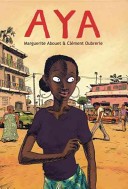
AYA
Written by Marguerite Abouet
Illustrated by Clément Oubrerie
Translation by Helge Dascher
Raincoast Books, 2007, 103 pp.
ISBN: 1-894937902
1978 was the year the Ivory Coast, my beautiful country, got to see its first television ad campaign. It was for Solibra, a local beer popular in all of West Africa. (p. 1)
This graphic novel is set in the 1970s, when the Ivory Coast, was coined the “Paris of the West.” The story begins by offering a refreshingly new perspective on the social life of a West African neighborhood. The contemporary dialogue is a much needed addition to the few translations of West African stories available on the western market.
AYA follows the relationship between Aya and her friends Adjoua and Bintou. The intertwining family dramas are insightful strands that not only make for an engaging story but also speak to the culture of a community where life is lived out in the open. Individual problems become public and not only discussed, but often resolved, within the greater community. For example, Adjoua’s pregnancy, the point of conflict in the story, moves from an individual situation to one of communal dialogue. Inquiries into an abortion end for Adjoua with Aya’s strong verbal intervention, “you’re nuts! That old witch ends pregnancies with a knitting needle. You don’t want to die do you?” (p. 57). Class issues are highlighted between the supposed father, Moussa, who is the son of the owner of the Solibra Beer Factory, and his mother when she learns he’s “knocked up…a working class girl” (p. 70). With worries about further community shame and humiliation, because Adjoua’s father works for the local newspaper Calamity Morning, Moussa’s parents agree to a quick wedding. Although the story deals with serious social issues, the tone is one intermixed with humor and surprise.
The preface provides insight into the political, economic and social proliferations that impacted the country’s independence in 1960, under the presidential leadership of Féliz Houphouët-Boignt. Abouet’s, AYA fills a real need to portray a modern African community against the dominant representations and images that propagate western perceptions of Africa as a monolithic continent that can only speak of revolutions, war, child soldiers, refugee camps, orphans, starvation, AIDS, and genocide. Abouet, drawing upon her childhood memories of growing up in Abídjan, the capital of the Ivory Coast, provides authentic insights into cultural values and traditions within a working class neighborhood called Yopougon, what the locals refer to as Yop City.
Abouet’s rich dialogues interwoven amongst Oubrerie’s colorful pastel and ink illustrations embellish evocative moods and secretive lighting of many flirtatious desires, while also depicting realist and authentic contemporary African lifestyles. The illustrations honor the book’s authenticity, serving as a pictorial bridge to provide insight into class divisions with modern homes, contemporary furnishings, and stylish clothes. Bonus pages showcase tutorials on how to roll your tassaba (your behind), wrap a pagne (a skirt or head scarf) and a colorful glossary defining the slang terms for the male reproductive organ, outdoor dance spaces, and terms of respect.
Abouet’s AYA, series originally translated from French, goes well beyond demystifying the common western portrayals of life on the African continent. A strong text comparison that provides similar insights into diverse cultures is Sherman Alexie’s The Absolutely True Diary of a Part time Indian (2007). It is a thoughtful match to AYA both in style and humorous storyline. Both novels open up new social worlds for the traditional western reader. The young adult graphic novel, The Complete Persepolis (2007) by Marjane Satrapi similarly parallels AYA in its storyline of a young Iranian girl’s maturation within a rich family life. Both stories are voices not often heard against the backdrop of media events that primarily document a country’s power struggles or visages of war. All three books are similar in their cultural revelations and authentic portrayals by providing insider perspectives whose contrasts are critical intersections when considering western conservative publishing parameters. Side stepping these conformities, and in efforts to preserve the colorful mores of Yop City, Abouet chose to publish her young adult novel in a graphic style where culturally authentic languages and lifestyles are not compromised into a censored and water down version.
Marguerite Abouet’s book AYA is first in a series of four that follow the interconnecting lives of Aya’s family, her friends’ families, and other neighborhood connections: AYA of Yop City (2008); AYA The Secrets Come Out (2009); and AYA Love in Yop City (2012).
Jennifer Buntier, University of New Mexico, Albuquerque, NM
WOW Review, Volume V, Issue 2 by Worlds of Words is licensed under a Creative Commons Attribution-NonCommercial-ShareAlike 4.0 International License. Based on work at https://wowlit.org/on-line-publications/review/v-2/

Congratulations to author Anne de Graaf and Eerdmans Books for Young Readers for today’s 2013 Batchelder Honor Book Award for Son of a Gun. The Batchelder is awarded by ALSC for the most outstanding books originally published in a foreign language in a foreign country, and subsequently translated into English and published in the United States. Read more at: http://www.ala.org/alsc/awardsgrants/bookmedia/batchelderaward